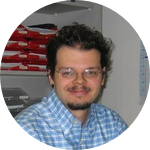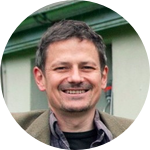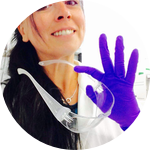About This Project
The TDP-43 protein is involved in amyotrophic lateral sclerosis (ALS) and in frontotemporal dementia (FTLD). Furthermore, TDP-43 pathology has been associated with Alzheimer's and Parkinson’s diseases (Neuman M, Int J Mol Sci, 2009). It is becoming increasingly necessary to investigate the normal and pathological functions of this protein, whose purification is difficult to achieve as none has succeeded yet, but my preliminary results indicate that this is indeed possible.
Ask the Scientists
Join The DiscussionWhat is the context of this research?
The fundamental question I am trying to answer is what is the role of TDP-43, and how and why this protein is involved in several neurodegenerative disorders, which all display accumulations of misfolded TDP-43. So far, several attempts to purify the full-length protein have failed worldwide due to its biochemical properties and to its proneness to aggregation. In order to obtain its three-dimensional structure, which is of vital importance for studying its aggregation process, its structure-function relationship and the role of the pathologically relevant mutations, I should obtain a pure protein. My preliminary results suggest that this is indeed achievable. To do so, I would need to extensively use the instrument FPLC, a tool that will make the process easier and faster.
What is the significance of this project?
Neurodegenerative diseases represent an enormous disease burden, in terms of human suffering and economic cost. These diseases have touched many of our lives: changes in behavior and personality of our loved ones are the most challenging and distressing part of these diseases. Given the central role played by TDP-43 in these disorders (Cook C et al, Expert Opin Biol Ther. 2008; Buratti E, Adv Genet. 2009). and the difficulty in purifying this protein, our opportunities to progress on the understanding of these diseases are currently limited by the availability of a pure protein, which would opens an impressive number of studies on the pathobiology of this protein and opportunities to design rationally therapeutic strategies against its associated diseases.
What are the goals of the project?
The ultimate goal of this project is to purify the full-length TDP-43 to its native form. It will be first produced in the E. coli bacteria, then subjected to different possible strategies of purification, which will require not only a very skilled person in protein chemistry, but also an extensive use of the FPLC instrument. I will then continue to optimize the yield-to-cost ratio of the purification procedure, with the help of the FPLC equipment, and will obtain the tridimensional structure of full-length TDP-43.
I am very confident in the success of this challenging endeavor; for this reason I will focus our studies also on the other forms (pathological mutants) of TDP-43, which will help us to elucidate its vital role in the cell.
Budget
The ultimate goal of this project is to purify the full-length TDP-43 to its native form. This will require not only a very skilled person in protein chemistry, but also an extensive use of the FPLC (Fast Protein Liquid Chromatography) instrument, which is vital for conducting the research project.
All other research-related expenses will be covered by Prof. Fabrizio Chiti's laboratory, at the University of Florence, Florence, Italy.
Endorsed by
 Project Timeline
Project Timeline
I will expect to obtain the pure protein in its full-length by December 2017; after conducting biochemical and biophysical experiments, my goal is to crystallise the TDP-43 in order to obtain the three-dimensional structure; as in the cells, TDP-43 exists also in other forms, and it displays mutations associated to the disease, I will focus my investigation on the characterisation of them, to full elucidate the pathobiology of this versatile protein.
Jul 15, 2017
Project Launched
Dec 20, 2017
Perform all the steps for the purification and optimisation of the protocol for the native full-length form of TDP-43
Jun 29, 2018
Crystallography experiments in order to obtain the three-dimensional structure of native TDP-43
Apr 30, 2019
Purification and characterisation of TDP-43 mutant forms
Meet the Team
Mirella Vivoli, PhD
I have been fascinated by science since my childhood, and I became interested in protein biochemistry during my education in Rome, Italy.
After getting a PhD in Biochemical Sciences at University of Rome Sapienza, Italy, I have spent two years as Postdoctoral fellow in the United States, at University of Baltimore, MD, and almost five year in the United Kingdom, at University of Exeter.
The extensive work I have done there, significantly improved my skills in the preparation and purification of proteins, allowing me to become an expert in protein chemistry.
Since October 2016, I have joined the Laboratory of Prof. Fabrizio Chiti, as Research Associate Fellow at University of Florence, Italy, providing me with a strong opportunity to add to the existing strengths in protein science, and to gain new skills in biophysics and cell biology.
My main interest in taking on this postdoctoral position was not only to further develop my understanding of protein structure and function, but also to "go against the grain".
It is well known that gifted Italian scientists have the tendency to emigrate, as I did myself in the past, due to the lack of political interventions, research funds, resources and facilities in Italy. Despite that, I think I can make the difference: I always pursue the implementation of my interests stubbornly and persistently due to the self-confidence and the awareness of my own strengths and acquired skills.
I will spend whatever time and energy are necessary to accomplish the task at hand.
Additional Information
ALL BACKERS WILL BE THANKED ONE BY ONE IN THE PAPER REGARDING THE TDP-43 RESEARCH.
Project Backers
- 249Backers
- 104%Funded
- $10,461Total Donations
- $42.01Average Donation





